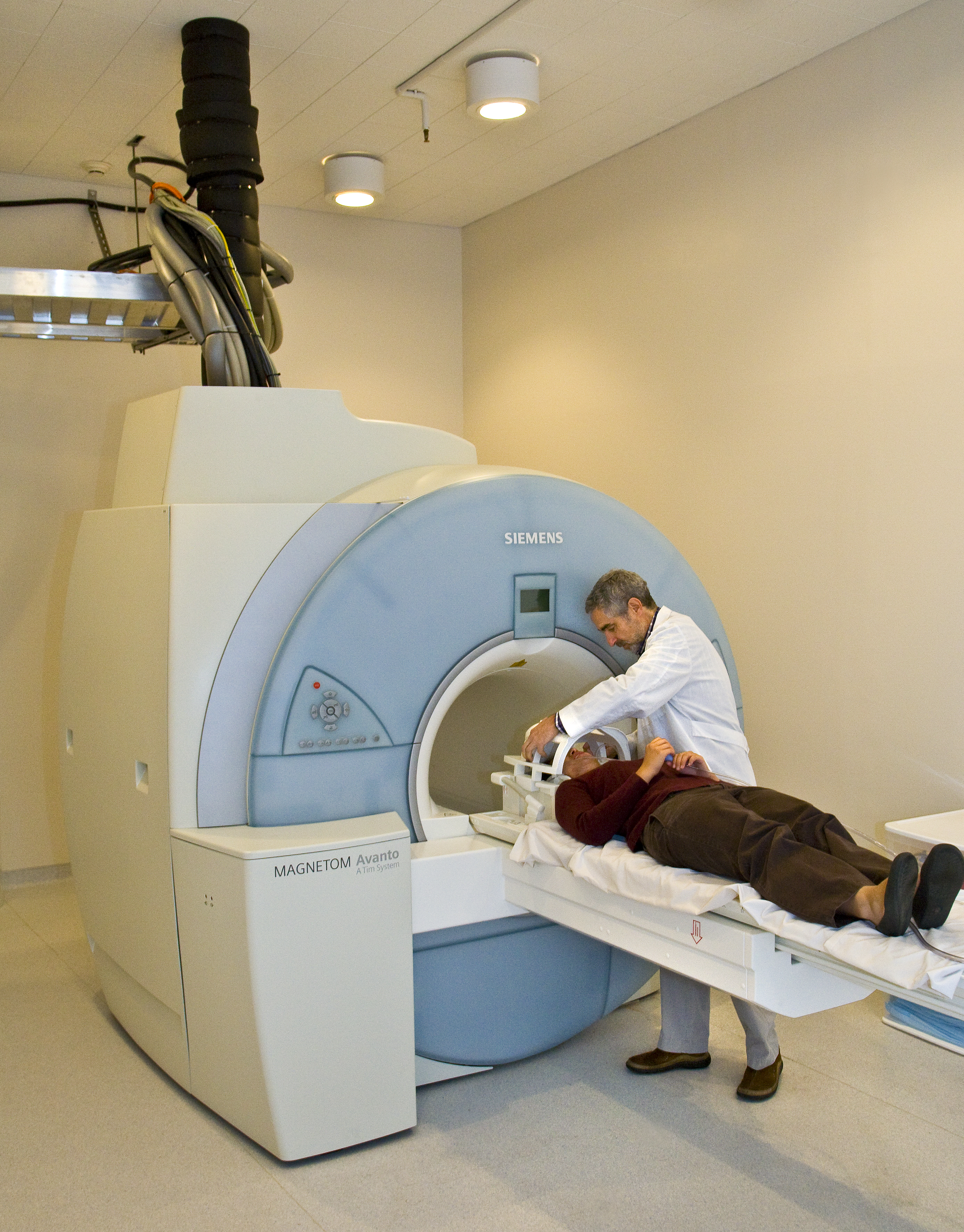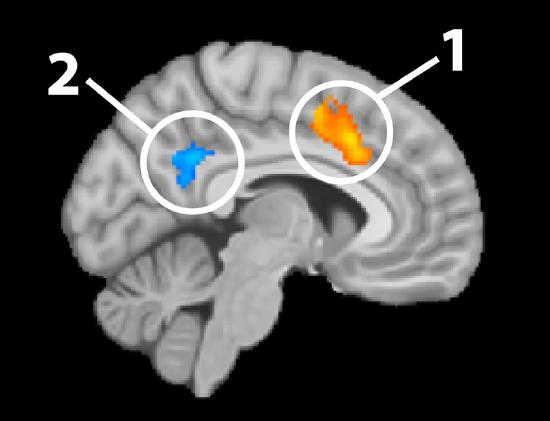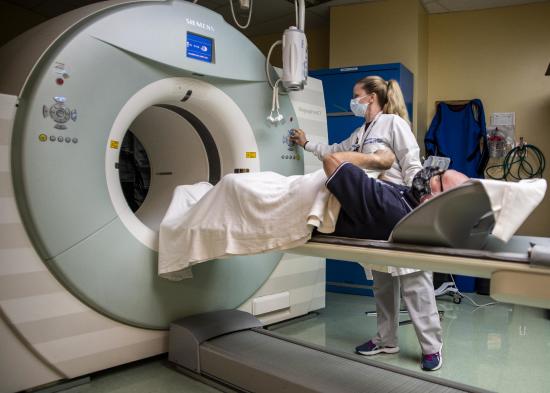2.4: Non-Invasive Techniques: Indirect Functional Imaging Techniques
- Page ID
- 110463
This page is a draft and under active development. Please forward any questions, comments, and/or feedback to the ASCCC OERI (oeri@asccc.org).
- Describe the key characteristics of indirect functional brain imaging techniques.
- In basic terms, describe functional MRI (fMRI) and positron emission tomography (PET).
- Discuss the pros and cons of FMRI and PET.
Overview
EEG and MEG are direct functional imaging techniques as they measure the actual activity in the brain. In this section, we will discuss what makes a technique an indirect brain imaging technique and the two main indirect imaging techniques, functional MRI (fMRI) and positron emission tomography (PET), will be introduced.
FMRI and PET
Indirect brain imaging techniques rely on an assumption that activity in the brain correlates to something else that we are able to measure. In these cases, these techniques measure blood flow in the brain. The assumption is that blood flow in the brain is related to the activity level in that area of the brain. Of course, with any assumption, there is always the risk that it could be wrong. Thankfully there is extensive research examining this assumption and the scientific consensus currently is that blood flow is an appropriate indication of brain activity. The two main indirect brain imaging techniques that we will cover are functional MRI (fMRI) and positron emission tomography (PET).
Functional magnetic resonance imaging (fMRI) is a method that is used to assess changes in the activity of tissue, such as measuring changes in neural activity in different areas of the brain during thoughts or experiences. This technique builds on the principles of structural MRI techniques and also uses the property that, when neurons fire, they use energy, which must be replenished. Glucose and oxygen, two key components for energy production, are supplied to the brain from the blood stream as needed. Oxygen is transported through the blood using hemoglobin, which contains binding sites for oxygen. When these sites are saturated with oxygen, it is referred to as oxygenated hemoglobin. When the oxygen molecules have all been released from a hemoglobin molecule, it is known as deoxygenated hemoglobin. As a set of neurons begin firing, oxygen in the blood surrounding those neurons is consumed, leading to a reduction in oxygenated hemoglobin. The body then compensates and provides an abundance of oxygenated hemoglobin in the blood surrounding that activated neural tissue. When activity in that neural tissue declines, the level of oxygenated hemoglobin slowly returns to its original level, which typically takes several seconds. Figure \(\PageIndex{1}\) shows a subject about to go into a functional MRI machine.

fMRI measures the change in the concentration of oxygenated hemoglobin, which is known as the blood-oxygen-level-dependent (BOLD) signal. This leads to two important facts about fMRI. First, fMRI measures blood volume and blood flow, and from this we infer neural activity; as stated previously, fMRI does not measure neural activity directly. Second, fMRI data typically have poor temporal resolution; however, when combined with structural MRI, fMRI provides excellent spatial resolution. Temporal resolution for fMRI is typically on the order of seconds, whereas its spatial resolution is on the order of millimeters. Generally speaking, under most conditions there is an inverse relationship between temporal and spatial resolution—one can increase temporal resolution at the expense of spatial resolution and vice versa. In other words, as one increases the other decreases.
This method is valuable for identifying specific areas of the brain that are associated with different physical or psychological tasks. Clinically, fMRI may be used prior to neurosurgery in order to identify the brain areas that are associated with language so that the surgeon can avoid those areas during the operation. fMRI allows researchers to identify differential or convergent patterns of activation associated with tasks. For example, if participants are shown words on a screen and are expected to indicate the color of the letters, are the same brain areas recruited for this task if the words have emotional content or not? Does this relationship change in psychological disorders such as anxiety or depression? Is there a different pattern of activation even in the absence of obvious performance differences? fMRI is an excellent tool for comparing brain activation in different tasks and/or populations. Figure \(\PageIndex{2}\) provides an example of results from fMRI analyses overlaid on a structural MRI image. The blue and orange shapes represent areas with significant changes in the BOLD signal, thus changes in neural activation.

Positron emission tomography (PET) is a medical imaging technique that is used to measure processes in the body, including the brain (see Figure \(\PageIndex{3}\) for a PET scanner). This method relies on a positron-emitting tracer atom that is introduced into the blood stream in a biologically active molecule, such as glucose, water, or ammonia. A positron is a particle much like an electron but with a positive charge. One example of a biologically active molecule is fludeoxyglucose, which acts similarly to glucose in the body. Fludeoxyglucose will concentrate in areas where glucose is needed—commonly areas with higher metabolic (energy) needs. Over time, this tracer molecule emits positrons, which are detected by a sensor. The spatial location of the tracer molecule in the brain can be determined based on the emitted positrons. This allows researchers to construct a three-dimensional image of the areas of the brain that have the highest metabolic needs, typically those that are most active. Images resulting from PET usually represent neural activity that has occurred over tens of minutes, which is very poor temporal resolution for some purposes. PET images are often combined with computed tomography (CT) images to improve spatial resolution, as fine as several millimeters. Tracers can also be incorporated into molecules that bind to neurotransmitter receptors, which allow researchers to answer some unique questions about the action of neurotransmitters. Unfortunately, very few research centers have the equipment required to obtain the images or the special equipment needed to create the positron-emitting tracer molecules, which typically need to be produced on site.

Using Indirect Functional Imaging Techniques to Study a Disorder: Autism Spectrum Disorder
PET and fMRI studies of ASD have found different levels of neuronal activity in the amygdala and the hippocampus compared to subjects without ASD. These areas are notable because they are a part of the “social brain.” These studies have largely focused on patients with ASD when they are viewing faces. As the viewing of faces is a large part of socializing (for example, reading expressions and making eye contact) and socializing is one area where many autistic patients have issues, these studies help provide further information for doctors and researchers to use. (See Philip et al. (2012) for a review of the fMRI studies of ASD.)
Summary
The use of indirect functional imaging techniques has allowed researchers and doctors to see which parts of the brain are active during various tasks. Both fMRI and PET allow researchers to measure blood flow in order to make conclusions about changes in brain activity. These techniques have excellent spatial resolution, but poor temporal resolution.
References
Philip, R. C. M., Dauvermann, M. R., Whalley, H. C., Baynham, K., Lawrie, S. M., & Stanfield, A. C. (2012). A systematic review and meta-analysis of the fmri investigation of Autism Spectrum Disorders. Neuroscience & Biobehavioral Reviews, 36(2), 901–942.
Attributions
- Psychophysiological Methods in Neuroscience by Zachary Infantolino and Gregory A. Miller is licensed under a CC BY-NC-SA 4.0 International License.
- Figure \(\PageIndex{1}\): "Neurodegenerative Diseases and Cognition" by Berkeley Lab is licensed under CC BY-NC-ND 2.0
- Figure \(\PageIndex{3}\): "NMCSD Nuclear Medicine Department Conducts PET Scan" is in the Public Domain


